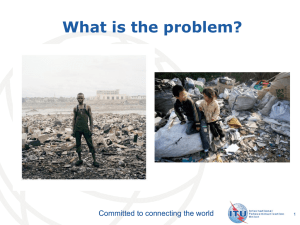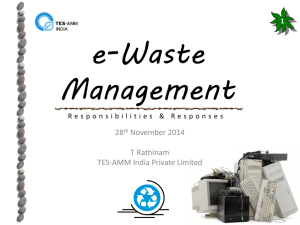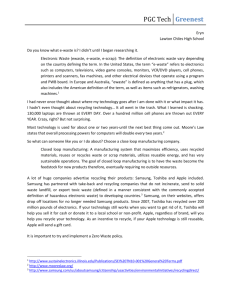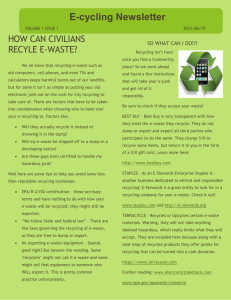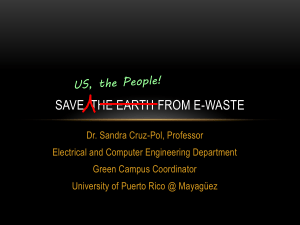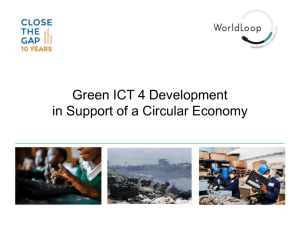Facts - MCI-EnvironmentalScience
advertisement
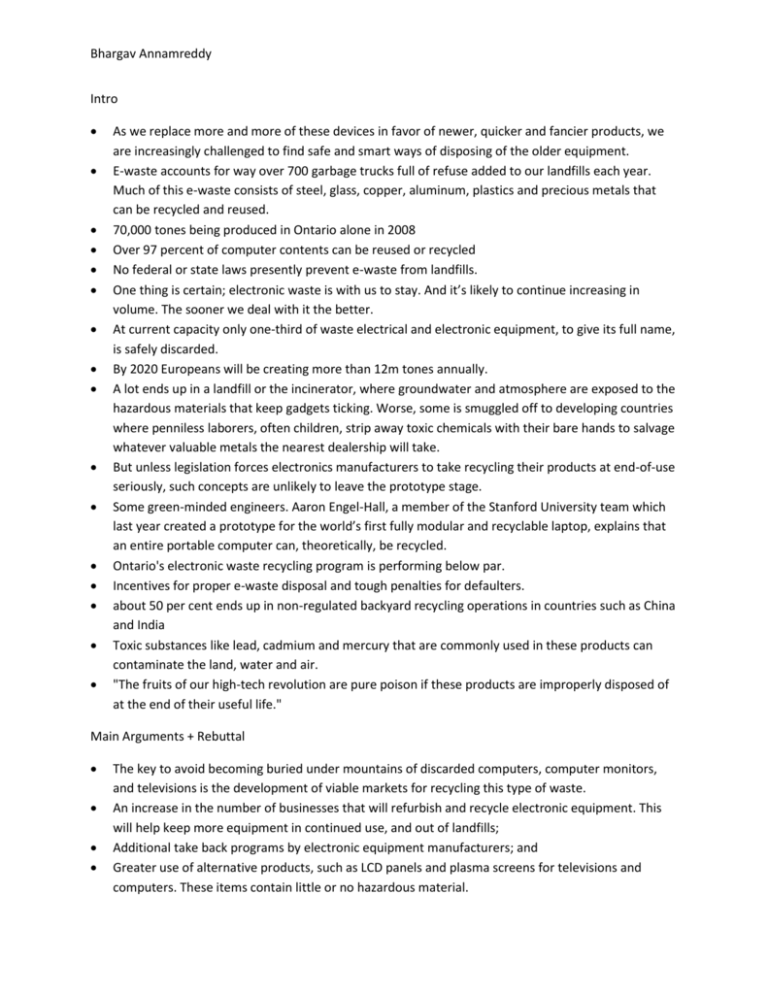
Bhargav Annamreddy Intro As we replace more and more of these devices in favor of newer, quicker and fancier products, we are increasingly challenged to find safe and smart ways of disposing of the older equipment. E-waste accounts for way over 700 garbage trucks full of refuse added to our landfills each year. Much of this e-waste consists of steel, glass, copper, aluminum, plastics and precious metals that can be recycled and reused. 70,000 tones being produced in Ontario alone in 2008 Over 97 percent of computer contents can be reused or recycled No federal or state laws presently prevent e-waste from landfills. One thing is certain; electronic waste is with us to stay. And it’s likely to continue increasing in volume. The sooner we deal with it the better. At current capacity only one-third of waste electrical and electronic equipment, to give its full name, is safely discarded. By 2020 Europeans will be creating more than 12m tones annually. A lot ends up in a landfill or the incinerator, where groundwater and atmosphere are exposed to the hazardous materials that keep gadgets ticking. Worse, some is smuggled off to developing countries where penniless laborers, often children, strip away toxic chemicals with their bare hands to salvage whatever valuable metals the nearest dealership will take. But unless legislation forces electronics manufacturers to take recycling their products at end-of-use seriously, such concepts are unlikely to leave the prototype stage. Some green-minded engineers. Aaron Engel-Hall, a member of the Stanford University team which last year created a prototype for the world’s first fully modular and recyclable laptop, explains that an entire portable computer can, theoretically, be recycled. Ontario's electronic waste recycling program is performing below par. Incentives for proper e-waste disposal and tough penalties for defaulters. about 50 per cent ends up in non-regulated backyard recycling operations in countries such as China and India Toxic substances like lead, cadmium and mercury that are commonly used in these products can contaminate the land, water and air. "The fruits of our high-tech revolution are pure poison if these products are improperly disposed of at the end of their useful life." Main Arguments + Rebuttal The key to avoid becoming buried under mountains of discarded computers, computer monitors, and televisions is the development of viable markets for recycling this type of waste. An increase in the number of businesses that will refurbish and recycle electronic equipment. This will help keep more equipment in continued use, and out of landfills; Additional take back programs by electronic equipment manufacturers; and Greater use of alternative products, such as LCD panels and plasma screens for televisions and computers. These items contain little or no hazardous material. Bhargav Annamreddy A lot ends up in a landfill or the incinerator, where groundwater and atmosphere are exposed to the hazardous materials that keep gadgets ticking. Worse, some is smuggled off to developing countries where penniless laborers, often children, strip away toxic chemicals with their bare hands to salvage whatever valuable metals the nearest dealership will take. Businesses warn of cost burdens offloaded onto consumers, who are unlikely to appreciate environmental gains they will never feel first-hand. Manufacturers would be encouraged to consult with recyclers on creating devices so that materials can be recovered after use. In a single year, roughly 1,600 tons of copper, 35 tons of silver, 1.5 tons of palladium, and 3.4 tons of gold could be recovered by recycling 100 million cell phones. According to reports from nearby Shantou University, Guiyu has the highest level of cancer-causing dioxins in the world and elevated rates of miscarriages. An estimated 50 to 80 percent of e-waste collected in the United States for recycling is exported to areas such as China, India or Pakistan recycling policies The reason is strictly financial. The U.S. Environmental Protection Agency estimates it's up to 10 times cheaper to export e-waste than to dispose of it domestically. But it is costing people lives. About 150,000 people are employed by the e-waste industry in Guiyu, China, and 25,000 more work in the scrapyards of New Delhi, India. The gold, silver, copper, aluminum and other metals salvaged become a vital resource for the manufacturing of new items. A typical wage for the arduous, dangerous work is $2 to $4 a day. Conclusion Going to increase. In South Africa and China for example, the report predicts that by 2020 e-waste from old computers will have jumped by 200 to 400 percent from 2007 levels, and by 500% in India Global e-waste generation is growing by about 40 million tons a year China, India South Africa, Uganda, Senegal, Kenya, Morocco Brazil, Columbia, Mexico, Peru The report recommends countries establish e-waste management centers of excellence, building on existing organizations working in the area of recycling and waste management. Is it really worth the lives of people? Should the developed nations be allowed dump their e- waste in third world countries? If so should thy not at least try to make some sort of arrangement so there is some safety? Why not turn e- waste into an industry? Ex. Designed in US, Manufactured in China, Recycled in Mexico Key words: tipping point, Degradation, Tragedy of the commons, Litho, bio, atmo, hydro Bhargav Annamreddy Links to Videos: http://storyofstuff.org/electronics/ http://www.youtube.com/watch?v=NBC-dWgElbI&feature=related http://www.youtube.com/watch?v=i3fOLL10yxY http://www.youtube.com/watch?v=dJ8nL2RBF4E&feature=related http://www.youtube.com/watch?v=3lNh1-WCOl8&feature=related




